

Compact Muon Solenoid
LHC, CERN
| CMS-HIN-15-010 ; CERN-EP-2017-133 | ||
| Principal-component analysis of two-particle azimuthal correlations in PbPb and pPb collisions at CMS | ||
| CMS Collaboration | ||
| 23 August 2017 | ||
| Phys. Rev. C 96 (2017) 064902 | ||
| Abstract: For the first time a principal-component analysis is used to separate out different orthogonal modes of the two-particle correlation matrix from heavy ion collisions. The analysis uses data from $\sqrt{s_{\mathrm{NN}}} = $ 2.76 TeV PbPb and $\sqrt{s_{\mathrm{NN}}} = $ 5.02 TeV pPb collisions collected by the CMS experiment at the LHC. Two-particle azimuthal correlations have been extensively used to study hydrodynamic flow in heavy ion collisions. Recently it has been shown that the expected factorization of two-particle results into a product of the constituent single-particle anisotropies is broken. The new information provided by these modes may shed light on the breakdown of flow factorization in heavy ion collisions. The first two modes ("leading" and "subleading") of two-particle correlations are presented for elliptical and triangular anisotropies in PbPb and pPb collisions as a function of $ p_{\mathrm{T}} $ over a wide range of event activity. The leading mode is found to be essentially equivalent to the anisotropy harmonic previously extracted from two-particle correlation methods. The subleading mode represents a new experimental observable and is shown to account for a large fraction of the factorization breaking recently observed at high transverse momentum. The principal-component analysis technique has also been applied to multiplicity fluctuations. These also show a subleading mode. The connection of these new results to previous studies of factorization is discussed. | ||
| Links: e-print arXiv:1708.07113 [nucl-ex] (PDF) ; CDS record ; inSPIRE record ; HepData record ; CADI line (restricted) ; | ||
| Figures | |

png pdf |
Figure 1:
Leading ($\alpha =$ 1) and subleading ($\alpha =$ 2) modes for $n=$ 2 as a function of $ {p_{\mathrm {T}}} $, measured in a wide centrality range of PbPb collisions at $ {\sqrt {{s_{_{\mathrm {NN}}}}}} = $ 2.76 TeV. The results for the leading mode ($\alpha =$ 1) are compared to the standard elliptic flow magnitude measured by ALICE and CMS using the two-particle correlation method taken from Refs. [7,15], respectively. The error bars correspond to statistical uncertainties and boxes to systematic ones. |
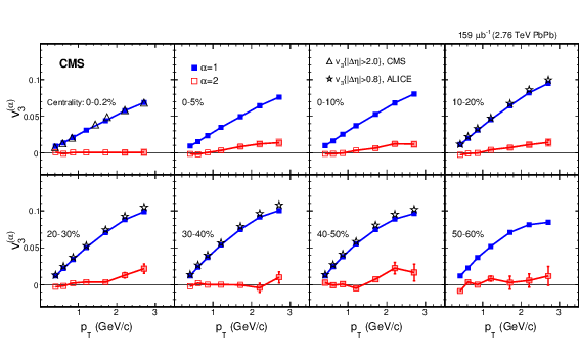
png pdf |
Figure 2:
Leading ($\alpha =$ 1) and subleading ($\alpha =$ 2) modes for $n=$ 3 as a function of $ {p_{\mathrm {T}}} $, measured in a wide centrality range of PbPb collisions at $ {\sqrt {{s_{_{\mathrm {NN}}}}}} = $ 2.76 TeV. The results for the leading mode ($\alpha =$ 1) are compared to the standard triangular flow magnitude measured by ALICE and CMS using the two-particle correlation method taken from Refs. [7,15], respectively. The error bars correspond to statistical uncertainties and boxes to systematic ones. |
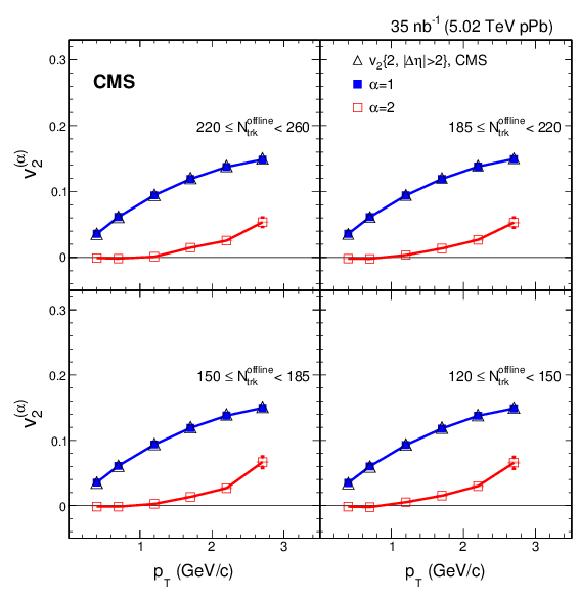
png pdf |
Figure 3:
Leading ($\alpha =$ 1) and subleading ($\alpha =$ 2) modes for $n=$ 2 as a function of $ {p_{\mathrm {T}}} $, measured in high-multiplicity pPb collisions at $ {\sqrt {{s_{_{\mathrm {NN}}}}}} = $ 5.02 TeV, for four classes of reconstructed track multiplicity $N^\text {offline}_{\text {trk}}$. The results for the leading mode ($\alpha =$ 1) are compared to the standard elliptic flow magnitude taken from Ref. [25]. The error bars correspond to statistical uncertainties and boxes to systematic ones. |
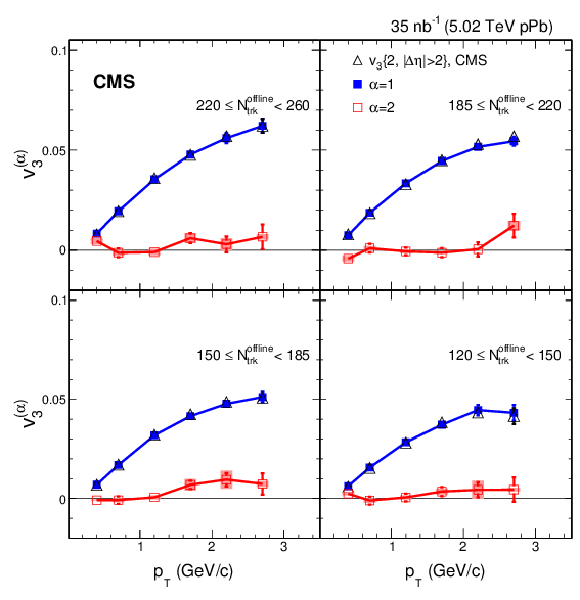
png pdf |
Figure 4:
Leading ($\alpha =$ 1) and subleading ($\alpha =$ 2) modes for $n=$ 3 as a function of $ {p_{\mathrm {T}}} $, measured in high-multiplicity pPb collisions at $ {\sqrt {{s_{_{\mathrm {NN}}}}}} = $ 5.02 TeV, for four classes of reconstructed track multiplicity $N^\text {offline}_{\text {trk}}$. The results for the leading mode ($\alpha =$ 1) are compared to the standard triangular flow magnitude taken from Ref. [25]. The error bars correspond to statistical uncertainties and boxes to systematic ones. |
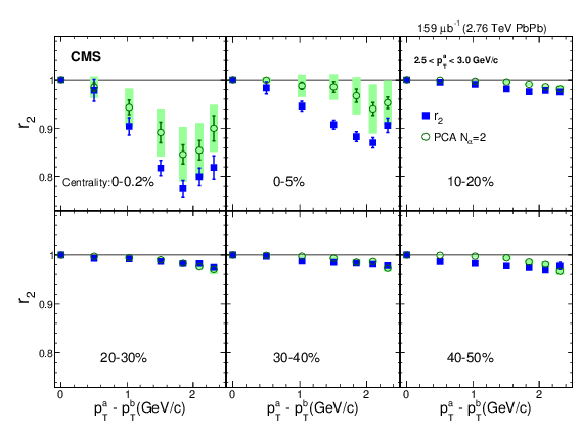
png pdf |
Figure 5:
Comparison of the Pearson correlation coefficient $r_2 $ reconstructed with harmonic decomposition using the leading and subleading modes and $r_2 $ values from Ref. [19], as a function of $ {p_{\mathrm {T}}} ^a- {p_{\mathrm {T}}} ^b$ in bin of $ {p_{\mathrm {T}}} ^a$ for six centrality classes in PbPb collisions at $ {\sqrt {{s_{_{\mathrm {NN}}}}}} = $ 2.76 TeV. The error bars correspond to statistical uncertainties and boxes to systematic ones. |
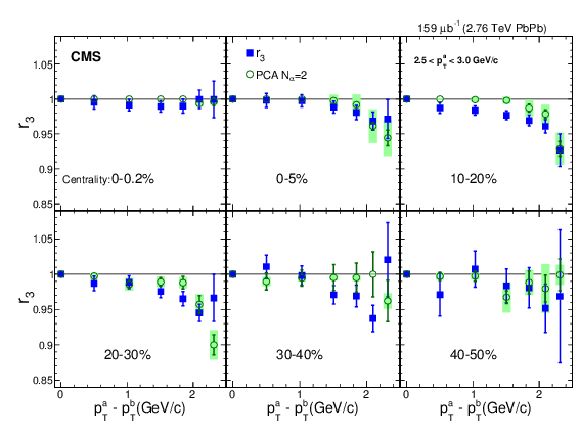
png pdf |
Figure 6:
Comparison of the Pearson correlation coefficient $r_3 $ reconstructed with harmonic decomposition using the leading and subleading modes and $r_3 $ values from Ref. [19], as a function of $ {p_{\mathrm {T}}} ^a- {p_{\mathrm {T}}} ^b$ in bin of $ {p_{\mathrm {T}}} ^a$ for six centrality classes in PbPb collisions at $ {\sqrt {{s_{_{\mathrm {NN}}}}}} = $ 2.76 TeV. The error bars correspond to statistical uncertainties and boxes to systematic ones. |
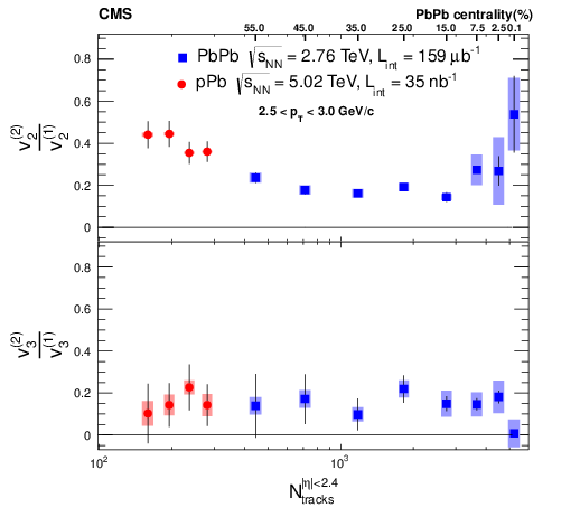
png pdf |
Figure 7:
The ratio between values of the subleading and leading modes, taken for the highest $ {p_{\mathrm {T}}} $ bin, as a function of centrality and of charged-particle multiplicity at midrapidity (double axis). The PCA flow results for PbPb collisions at $ {\sqrt {{s_{_{\mathrm {NN}}}}}} = $ 2.76 TeV (filled blue squares) and for pPb collisions at $ {\sqrt {{s_{_{\mathrm {NN}}}}}} = $ 5.02 TeV (filled red circles). The error bars correspond to statistical uncertainties and boxes to systematic ones. |

png pdf |
Figure 8:
Leading and subleading modes for $n=$ 0, i.e. fluctuations in the total multiplicity, spanning eight centralities in PbPb collisions at $ {\sqrt {{s_{_{\mathrm {NN}}}}}} = $ 2.76 TeV. The error bars correspond to statistical uncertainties and boxes to systematic ones. The systematic uncertainties are strongly correlated bin-to-bin. |
| Tables | |

png pdf |
Table 1:
Summary of estimated systematic uncertainties relative to the given mode for the last $ {p_{\mathrm {T}}} $ bin 2.5 $ < {p_{\mathrm {T}}} < $ 3.0 GeV/$c$ for PbPb and pPb data. |
| Summary |
|
For the first time the leading and subleading modes of elliptic and triangular flow have been measured for 5.02 TeV pPb and 2.76 TeV PbPb collisions. For PbPb collisions the leading and subleading modes of multiplicity fluctuations have also been measured. Since the principal component analysis uses all the information encoded in the covariance matrix, it provides increased sensitivity to fluctuations. For a very wide range of $ p_{\mathrm{T}} $ and centrality, the leading modes of the elliptic and triangular flow are found to be essentially equal to the anisotropy coefficients measured using the standard two-particle correlation method. For both the elliptic and triangular cases the subleading modes are non-zero and increase with $ p_{\mathrm{T}} $. This behavior reflects a breakdown of flow factorization at high $ p_{\mathrm{T}} $ in both the pPb and PbPb systems. For charged-particle multiplicity both the leading and subleading modes increase steadily from central to peripheral PbPb events. The leading mode depends only weakly upon $ p_{\mathrm{T}} $ while the subleading mode increases strongly with $ p_{\mathrm{T}} $. This centrality and $ p_{\mathrm{T}} $ dependence is suggestive of the presence of fluctuations in the radial flow. In summary the subleading modes of the principal-component analysis capture new information from the spectra of flow and multiplicity fluctuations and provide an efficient method to quantify the breakdown of factorization in two-particle correlations. |
| References | ||||
| 1 | BRAHMS Collaboration | Quark gluon plasma and color glass condensate at RHIC? The perspective from the BRAHMS experiment | NP A 757 (2005) 1 | nucl-ex/0410020 |
| 2 | PHOBOS Collaboration | The PHOBOS perspective on discoveries at RHIC | NP A 757 (2005) 28 | nucl-ex/0410022 |
| 3 | STAR Collaboration | Experimental and theoretical challenges in the search for the Quark Gluon Plasma: The STAR Collaboration's critical assessment of the evidence from RHIC collisions | NP A 757 (2005) 102 | nucl-ex/0501009 |
| 4 | PHENIX Collaboration | Formation of dense partonic matter in relativistic nucleus-nucleus collisions at RHIC: Experimental evaluation by the PHENIX collaboration | NP A 757 (2005) 184 | nucl-ex/0410003 |
| 5 | J.-Y. Ollitrault | Anisotropy as a signature of transverse collective flow | PRD 46 (1992) 2290 | |
| 6 | P. F. Kolb, J. Sollfrank, and U. Heinz | Anisotropic transverse flow and the quark hadron phase transition | PRC 62 (2000) 054909 | hep-ph/0006129 |
| 7 | ALICE Collaboration | Harmonic decomposition of two-particle angular correlations in Pb-Pb collisions at $ \sqrt{s_{\mathrm{NN}}} = $ 2.76 TeV | PLB 708 (2012) 249 | 1109.2501 |
| 8 | ALICE Collaboration | Elliptic flow of identified hadrons in Pb-Pb collisions at $ \sqrt{s_{\mathrm{NN}}} = $ 2.76 TeV | JHEP 06 (2015) 190 | 1405.4632 |
| 9 | ATLAS Collaboration | Measurement of the azimuthal anisotropy for charged particle production in $ \sqrt{s_{\mathrm{NN}}} = $ 2.76 TeV lead-lead collisions with the ATLAS detector | PRC 86 (2012) 014907 | 1203.3087 |
| 10 | ATLAS Collaboration | Measurement of the distributions of event-by-event flow harmonics in lead-lead collisions at $ \sqrt{s_{\mathrm{NN}}} = $ 2.76 TeV with the ATLAS detector at the LHC | JHEP 11 (2013) 183 | 1305.2942 |
| 11 | ATLAS Collaboration | Measurement of event-plane correlations in $ \sqrt{s_{\mathrm{NN}}} = $ 2.76 TeV lead-lead collisions with the ATLAS detector | PRC 90 (2014) 024905 | 1403.0489 |
| 12 | CMS Collaboration | Centrality dependence of dihadron correlations and azimuthal anisotropy harmonics in PbPb collisions at $ \sqrt{s_{\mathrm{NN}}} = $ 2.76 TeV | EPJC 72 (2012) 2012 | CMS-HIN-11-006 1201.3158 |
| 13 | CMS Collaboration | Measurement of the elliptic anisotropy of charged particles produced in PbPb collisions at $ \sqrt{s_{\mathrm{NN}}} = $ 2.76 TeV | PRC 87 (2013) 014902 | CMS-HIN-10-002 1204.1409 |
| 14 | CMS Collaboration | Measurement of higher-order harmonic azimuthal anisotropy in PbPb collisions at $ \sqrt{s_{\mathrm{NN}}} = $ 2.76 TeV | PRC 89 (2014) 044906 | CMS-HIN-11-005 1310.8651 |
| 15 | CMS Collaboration | Studies of azimuthal dihadron correlations in ultra-central PbPb collisions at $ \sqrt{s_{\mathrm{NN}}} = $ 2.76 TeV | JHEP 02 (2014) 088 | CMS-HIN-12-011 1312.1845 |
| 16 | B. Schenke, S. Jeon, and C. Gale | (3+1)D hydrodynamic simulation of relativistic heavy-ion collisions | PRC 82 (2010) 014903 | 1004.1408 |
| 17 | C. Shen et al. | The iEBE-VISHNU code package for relativistic heavy-ion collisions | CPC 199 (2016) 61 | 1409.8164 |
| 18 | K. Dusling and D. Teaney | Simulating elliptic flow with viscous hydrodynamics | PRC 77 (2008) 034905 | 0710.5932 |
| 19 | CMS Collaboration | Evidence for transverse momentum and pseudorapidity dependent event plane fluctuations in PbPb and pPb collisions | PRC 92 (2015) 034911 | CMS-HIN-14-012 1503.01692 |
| 20 | F. G. Gardim, F. Grassi, M. Luzum, and J.-Y. Ollitrault | Breaking of factorization of two-particle correlations in hydrodynamics | PRC 87 (2013) 031901 | 1211.0989 |
| 21 | U. Heinz, Z. Qiu, and C. Shen | Fluctuating flow angles and anisotropic flow measurements | PRC 87 (2013) 034913 | 1302.3535 |
| 22 | R. S. Bhalerao, J.-Y. Ollitrault, S. Pal, and D. Teaney | Principal component analysis of event-by-event fluctuations | PRL 114 (2015) 152301 | 1410.7739 |
| 23 | CMS Collaboration, A. Grachov and others | Performance of the combined zero degree calorimeter for CMS | in XXX Int. Conf. on Calorimetry in High Energy Physics (CALOR 2008), M. Livan, ed., p. 012059 2009 (J. Phys.: Conf. Series, 160 (2009) 012059) | 0807.0785 |
| 24 | CMS Collaboration | The CMS experiment at the CERN LHC | JINST 3 (2008) S08004 | CMS-00-001 |
| 25 | CMS Collaboration | Multiplicity and transverse momentum dependence of two- and four-particle correlations in pPb and PbPb collisions | PLB 724 (2013) 213 | CMS-HIN-13-002 1305.0609 |
| 26 | \O. Djuvsland and J. Nystrand | Single and double photonuclear excitations in Pb+Pb collisions at $ \sqrt{s_{\mathrm{NN}}} = $ 2.76 TeV at the CERN Large Hadron Collider | PRC 83 (2011) 041901 | 1011.4908 |
| 27 | I. P. Lokhtin and A. M. Snigirev | A model of jet quenching in ultrarelativistic heavy ion collisions and high-$ p_T $ hadron spectra at RHIC | EPJC 45 (2005) 211 | nucl-ex/0506189 |
| 28 | S. Porteboeuf, T. Pierog, and K. Werner | Producing hard processes regarding the complete event: The EPOS event generator | 1006.2967 | |
| 29 | M. Gyulassy and X.-N. Wang | HIJING 1.0: A Monte Carlo program for parton and particle production in high energy hadronic and nuclear collisions | CPC 83 (1994) 307 | nucl-th/9502021 |
| 30 | CMS Collaboration | Tracking and vertexing results from first collisions | CMS-PAS-TRK-10-001 | |
| 31 | A. Mazeliauskas and D. Teaney | Fluctuations of harmonic and radial flow in heavy ion collisions with principal components | PRC 93 (2016) 024913 | 1509.07492 |
| 32 | A. Mazeliauskas and D. Teaney | Subleading harmonic flows in hydrodynamic simulations of heavy ion collisions | PRC 91 (2015) 044902 | 1501.03138 |
| 33 | N. Borghini and J.-Y. Ollitrault | Momentum spectra, anisotropic flow, and ideal fluids | PLB 642 (2006) 227 | nucl-ex/0506045 |

|
Compact Muon Solenoid LHC, CERN |

|

|

|

|

|

|